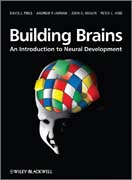
Building brains: an introduction to neural development
Price, David
Jarman, Andrew P.
Mason, John O.
The development of a brain from its simple beginnings in the embryo to the extraordinarily complex fully-functional adult structure is a truly remarkable process. Understanding how it occurs remains a formidable challenge despite enormous advances over the last century and current intense world-wide scientificresearch. A greater knowledge of how nervous systems construct themselves will bring huge benefits for human health and future technologies. Unravelling the mechanisms that lead to the development of healthy brains should help scientists tackle currently incurable diseases of the nervous system such as autism,epilepsy and schizophrenia (to name but a few), discover more about the processes that cause the uncontrolled growth associated with cancer and develop possible treatments. Building Brains provides a highly visual and readily accessible introduction to the main events that occur during neural development and the mechanisms by which they occur. Aimed at undergraduate students and postgraduates new to the field, who may not have a background in neuroscience and/or molecular genetics, it explains how cells in the early embryo first become neural, how their proliferation is controlled, what regulates the types of neuralcells they become, how neurons connect to each other, how these connections are later refined under the influence of neural activity including that arisingfrom experience, and why some neurons normally die. Key Features: A concise illustrated guide focusing on the core elements of current understanding of neural development, emphasising common principles underlying developmental mechanisms and supplemented by suggestions for further reading. Text boxes throughout provide further detail on selected major advances, issues of particular uncertainty or controversy and examples of human diseases that result from abnormal development. A balanced mammalian/non-mammalian perspective, drawing on examples from model organisms including the fruit fly, nematode worm, frog, zebrafish, chick, mouse, ferret, cat, monkey and human, and emphasising mechanisms that are conserved across species. Introduces the methods for studying neural development including genetics, transgenic technologies, advanced microscopy and computational modeling, allowing the reader to understand the main evidence underlying research advances. Student-friendly, full colour artwork reinforcesimportant concepts; an extensive glossary and definitions in page margins help readers from different backgrounds; chapter summaries stress important points and aid revision. Associated Website includes a complete set of figures fromthe textbook. INDICE: CHAPTER 1: MODELS AND METHODS FOR STUDYING NEURAL DEVELOPMENT 1.1 What is neural development?1.2 Why research neural development?1.3 Major breakthroughs that have contributed to understanding developmental mechanisms1.4 Invertebrate model organisms1.5 Vertebrate model organisms1.6 Other experimentalmethods for studying neural development and the use of formal theoretical models CHAPTER 2: THE ANATOMY OF DEVELOPING NERVOUS SYSTEMS 2.1 The nervous system develops from the embryonic neuroectoderm 2.2 Anatomical terms used to describe locations in embryos2.3 Development of the neuroectoderm of invertebrates2.4 Development of the neuroectoderm of vertebrates and the process of neurulation2.5 Secondary neurulation in vertebrates2.6 Formation of invertebrate and vertebrate peripheral nervous systems CHAPTER 3: NEURAL INDUCTION; AN EARLY EXAMPLE OF HOW INTERCELLULAR SIGNALLING DETERMINES CELL FATES 3.1 What is neural induction?3.2 Specification and commitment 3.3 The discovery of neural induction 3.4 A more recent breakthrough: identifying molecules that mediate neural induction 3.5 Conservation of neural induction mechanisms in Drosophila 3.6 Beyond the default model; other signalling pathways involved in neural induction3.7 Signal transduction: how cells respond to intercellular signals 3.8 Intercellular signalling regulates gene expression3.9 The essence of development: a complex interplay of intercellular CHAPTER 4: PATTERNING THE NEUROECTODERM 4.1 Regional patterning of the nervous system4.2 Patterning the anteroposterior (AP) axis of the Drosophila CNS4.3 Patterning the AP axis of the vertebrate CNS4.4 Refining AP axis information within regions and segments4.5 Patterning the dorsoventral (DV) axis of the nervous system4.6 Bringing it all together: coordinating pattern information in the Drosophila CNS4.7 Summary CHAPTER 5: NEUROGENESIS - GENERATING NEURAL CELLS 5.1 Generating neurons5.2 Neurogenesis in Drosophila5.3 Neurogenesis in vertebrates5.4 The regulation of neuronal subtype identity5.5 The regulation of cell proliferation during neurogenesis5.6 Temporal regulation of neural identity5.7 Why do we need to know about neurogenesis?5.8 Summary CHAPTER 6: NEURONAL MIGRATION 6.1 Many neurons migrate long distances during formation of the nervous system6.2 How can neuronal migration be observed6.3 Major modes of migration6.4 Initiation of migration6.5 How are migrating cells guided to their destinations?6.6 Locomotion6.7 Journey's end - termination of migration6.8 The mechanisms governing migration of important populations of cortical neurons remain unknown6.9 Conclusion CHAPTER 7: HOW NEURONS DEVELOP THEIR SHAPES 7.1 Neurons form two specialised types of outgrowth7.2 The growing neurite7.3 Stages of neurite outgrowth7.4 Neurite outgrowth is influenced by a neuron's surroundings7.5 Molecular responses in the growth cone7.6 Active transport along the axon is important for outgrowth7.7 The development of neuronal polarity7
- ISBN: 978-0-470-71229-0
- Editorial: John Wiley & Sons
- Encuadernacion: Rústica
- Páginas: 360
- Fecha Publicación: 15/04/2011
- Nº Volúmenes: 1
- Idioma: Inglés
